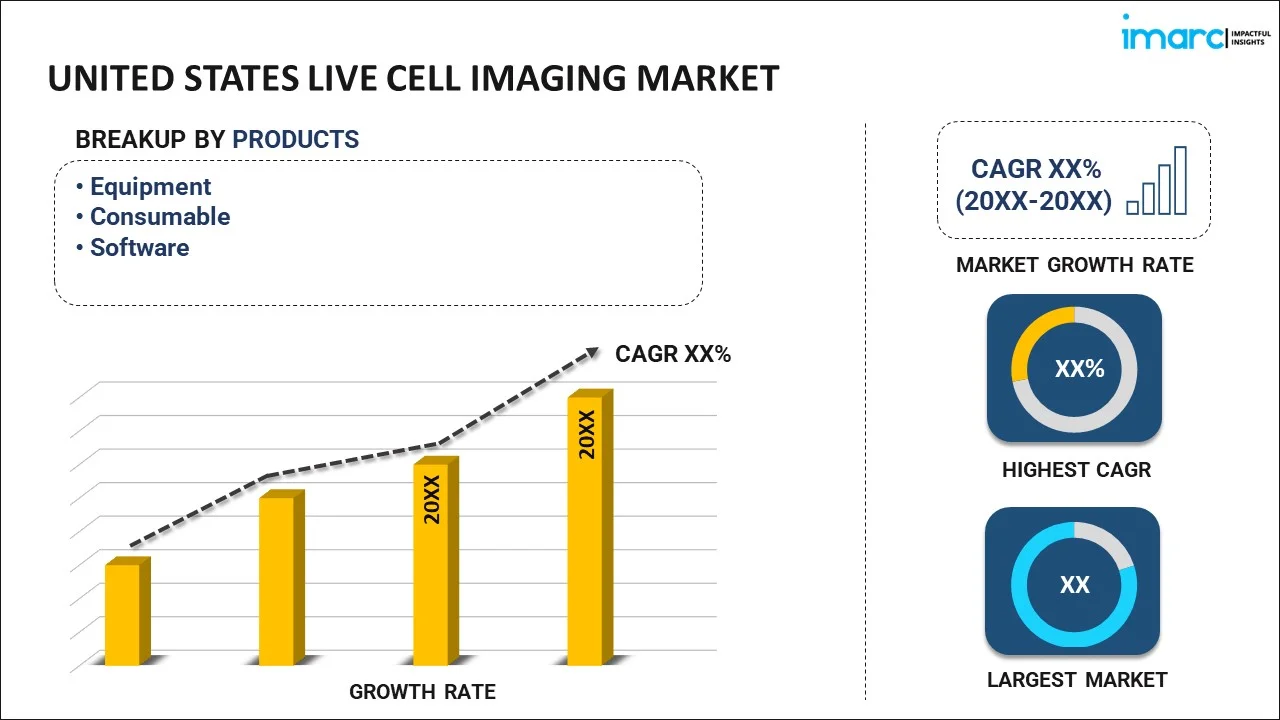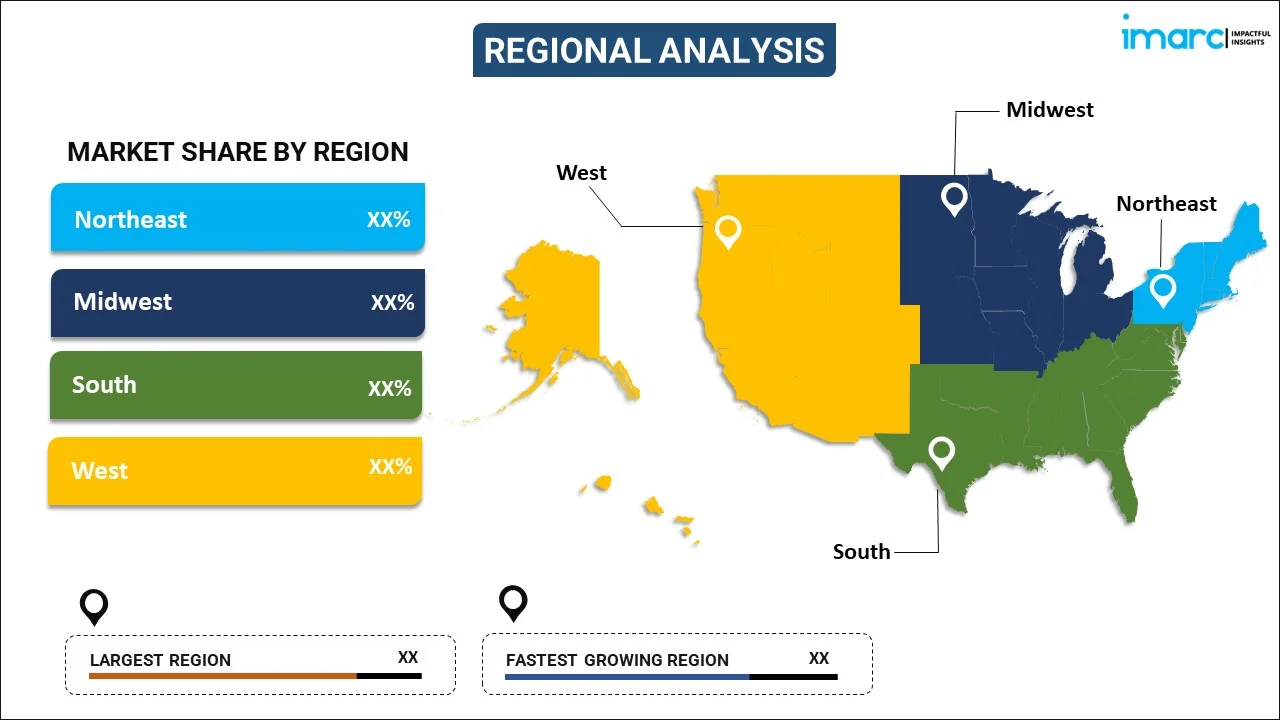
United States Live Cell Imaging Market Report by Product (Equipment, Consumable, Software), Application (Cell Biology, Developmental Biology, Stem Cell and Drug Discovery, and Others), Technology (Time-Lapse Microscopy, Fluorescence Recovery after Photobleaching (FRAP), Fluorescence Resonance Energy Transfer (FRET), High Content Screening (HCS), and Others), and Region 2025-2033
Market Overview:
United States live cell imaging market size reached USD 626 Million in 2024. Looking forward, IMARC Group expects the market to reach USD 1,261 Million by 2033, exhibiting a growth rate (CAGR) of 8.1% during 2025-2033. The rising investments in R&D activities by pharmaceutical companies to assess drug efficacy and develop enhanced therapeutic solutions for patients are primarily propelling the market growth across the country.
|
Report Attribute
|
Key Statistics
|
|---|---|
|
Base Year
|
2024 |
|
Forecast Years
|
2025-2033
|
|
Historical Years
|
2019-2024
|
| Market Size in 2024 | USD 626 Million |
| Market Forecast in 2033 | USD 1,261 Million |
| Market Growth Rate (2025-2033) | 8.1% |
Live cell imaging stands as an important method in the scientific realm, enabling the observation of dynamic living cells within their growth medium as they undergo temporal transformations. The process involves numerous protocols and techniques, facilitating cell culture on the microscope stage while maintaining a consistent focal plane to track real-time cellular processes. Essential factors, such as imaging modality, media conditions, temperature, humidity, pH, osmolarity, photon dose, etc., influence the imaging outcomes, playing a crucial role in sustaining cellular health. Live cell imaging's versatility extends to monitoring cell fusion events, assessing molecular mobility through techniques like fluorescence recovery after photobleaching (FRAP), and gauging modifications such as growth or aging of condensate over time. It is indispensable for investigating fertilization, cellular development, signaling processes, etc., thereby providing invaluable insights to biologists, pharmacologists, and toxicologists.
United States Live Cell Imaging Market Trends:
The United States live cell imaging market is driven by the continuous advancements in microscopy technologies. Cutting-edge innovations, such as super-resolution microscopy and light-sheet microscopy, are enhancing spatial resolution and enabling researchers to delve deeper into the intricacies of cellular processes. Moreover, the rising integration of artificial intelligence (AI) and machine learning in live cell imaging is emerging as a significant trend. These technologies encourage researchers to analyze vast amounts of imaging data efficiently, accelerating the pace of discoveries and unlocking new insights into cellular behavior. Besides this, another key trend involves the growing applications of live cell imaging in drug discovery and development, which is positively influencing the market growth in the United States. Furthermore, pharmaceutical companies are increasingly relying on this technique to assess drug efficacy and toxicity in real time, streamlining the drug development process and reducing costs. These trends not only propel the field forward but also underline the pivotal role live cell imaging plays in advancing biomedical research and therapeutic innovation, which in turn, will continue to bolster the market growth in the coming years.
United States Live Cell Imaging Market Segmentation:
IMARC Group provides an analysis of the key trends in each segment of the market, along with forecasts at the country level for 2025-2033. Our report has categorized the market based on product, application, and technology.
Product Insights:

- Equipment
- Consumable
- Software
The report has provided a detailed breakup and analysis of the market based on the product. This includes equipment, consumable, and software.
Application Insights:
- Cell Biology
- Developmental Biology
- Stem Cell and Drug Discovery
- Others
A detailed breakup and analysis of the market based on the application have also been provided in the report. This includes cell biology, developmental biology, stem cell and drug discovery, and others.
Technology Insights:
- Time-Lapse Microscopy
- Fluorescence Recovery after Photobleaching (FRAP)
- Fluorescence Resonance Energy Transfer (FRET)
- High Content Screening (HCS)
- Others
The report has provided a detailed breakup and analysis of the market based on the technology. This includes time-lapse microscopy, fluorescence recovery after photobleaching (FRAP), fluorescence resonance energy transfer (FRET), high content screening (HCS), and others.
Regional Insights:

- Northeast
- Midwest
- South
- West
The report has also provided a comprehensive analysis of all the major regional markets, which include the Northeast, Midwest, South, and West.
Competitive Landscape:
The market research report has also provided a comprehensive analysis of the competitive landscape in the market. Competitive analysis such as market structure, key player positioning, top winning strategies, competitive dashboard, and company evaluation quadrant has been covered in the report. Also, detailed profiles of all major companies have been provided.
United States Live Cell Imaging Market Report Coverage:
| Report Features | Details |
|---|---|
| Base Year of the Analysis | 2024 |
| Historical Period | 2019-2024 |
| Forecast Period | 2025-2033 |
| Units | Million USD |
| Scope of the Report | Exploration of Historical and Forecast Trends, Industry Catalysts and Challenges, Segment-Wise Historical and Predictive Market Assessment:
|
| Products Covered | Equipment, Consumable, Software |
| Applications Covered | Cell Biology, Developmental Biology, Stem Cell and Drug Discovery, Others |
| Technologies Covered | Time-Lapse Microscopy, Fluorescence Recovery after Photobleaching (FRAP), Fluorescence Resonance Energy Transfer (FRET), High Content Screening (HCS), Others |
| Regions Covered | Northeast, Midwest, South, West |
| Customization Scope | 10% Free Customization |
| Post-Sale Analyst Support | 10-12 Weeks |
| Delivery Format | PDF and Excel through Email (We can also provide the editable version of the report in PPT/Word format on special request) |
Key Questions Answered in This Report:
- How has the United States live cell imaging market performed so far and how will it perform in the coming years?
- What has been the impact of COVID-19 on the United States live cell imaging market?
- What is the breakup of the United States live cell imaging market on the basis of product?
- What is the breakup of the United States live cell imaging market on the basis of application?
- What is the breakup of the United States live cell imaging market on the basis of technology?
- What are the various stages in the value chain of the United States live cell imaging market?
- What are the key driving factors and challenges in the United States live cell imaging?
- What is the structure of the United States live cell imaging market and who are the key players?
- What is the degree of competition in the United States live cell imaging market?
Key Benefits for Stakeholders:
- IMARC’s industry report offers a comprehensive quantitative analysis of various market segments, historical and current market trends, market forecasts, and dynamics of the United States live cell imaging market from 2019-2033.
- The research report provides the latest information on the market drivers, challenges, and opportunities in the United States live cell imaging market.
- Porter's five forces analysis assist stakeholders in assessing the impact of new entrants, competitive rivalry, supplier power, buyer power, and the threat of substitution. It helps stakeholders to analyze the level of competition within the United States live cell imaging industry and its attractiveness.
- A competitive landscape allows stakeholders to understand their competitive environment and provides an insight into the current positions of key players in the market.
Need more help?
- Speak to our experienced analysts for insights on the current market scenarios.
- Include additional segments and countries to customize the report as per your requirement.
- Gain an unparalleled competitive advantage in your domain by understanding how to utilize the report and positively impacting your operations and revenue.
- For further assistance, please connect with our analysts.
 Inquire Before Buying
Inquire Before Buying
 Speak to an Analyst
Speak to an Analyst
 Request Brochure
Request Brochure
 Request Customization
Request Customization




.webp)




.webp)












